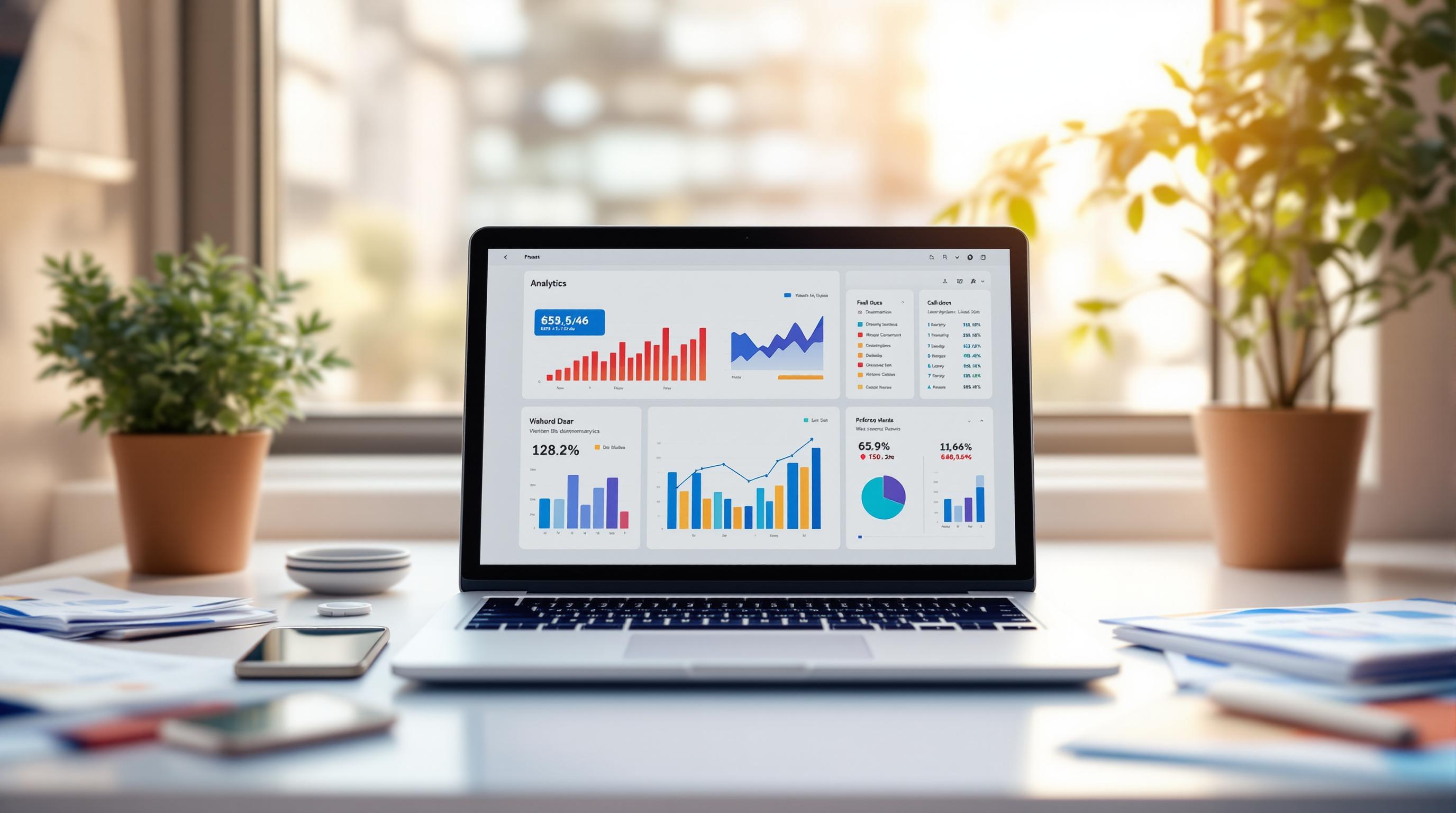To succeed in 2025, B2B marketers must focus on metrics that directly impact business results. Here’s a quick rundown of the 7 essential metrics every team should track:
- Customer Acquisition Cost (CAC): Know how much you spend to acquire each customer. Track marketing, sales, and overhead costs to optimize spending.
- Customer Lifetime Value (CLV): Measure the long-term revenue a customer brings. Focus on retention, upsells, and renewals to maximize value.
- Pipeline Velocity: Monitor how quickly deals move through your sales pipeline. Identify bottlenecks to improve efficiency.
- Lead-to-MQL Conversion Rate: Check if your leads are high-quality by tracking how many convert into Marketing Qualified Leads (MQLs).
- MQL-to-SQL Conversion Rate: Ensure smooth handoffs between marketing and sales by measuring how many MQLs turn into Sales Qualified Leads (SQLs).
- Return on Ad Spend (ROAS): Evaluate how much revenue your ad campaigns generate for every dollar spent.
- Account Engagement Score: Track how engaged potential buyers are with your brand through their actions (e.g., downloads, meetings).
Why These Metrics Matter
- Budget Metrics: Cut waste and spend smarter.
- Performance Metrics: Fix underperforming campaigns.
- Impact Metrics: Prove your marketing’s value to the business.
By aligning these metrics with business goals and leveraging AI tools, you can track trends, optimize strategies, and stay ahead in 2025. Start measuring what matters today!
Related video from YouTube
1. Customer Acquisition Cost (CAC): Measuring Marketing Efficiency
Want to know if your marketing dollars are working hard enough? That's where Customer Acquisition Cost (CAC) comes in. It's the cold, hard truth about how much money you're spending to win each new customer.
Think of CAC as your marketing report card. Just divide what you spend on getting customers by the number of customers you get. For B2B companies, you're typically looking at $100 to $1,000 per customer - though this can swing wildly depending on what you're selling.
Here's what goes into your CAC math:
| Cost Component | What to Include | Impact on CAC |
|---|---|---|
| Marketing Costs | Ad spend, content creation, tools | Direct influence |
| Sales Expenses | Team salaries, commissions, CRM | Major factor |
| Overhead | Software, utilities, office space | Partial allocation |
Let's break it down with a real example: Say you notice your Facebook ads aren't bringing in leads, but your LinkedIn campaigns are crushing it. Moving your budget from Facebook to LinkedIn could instantly drop your CAC while keeping your lead quality high.
Keep your eyes on CAC like a hawk - check it monthly or quarterly. Compare your numbers against others in your industry and your past performance. It's like having a fitness tracker for your marketing spend.
Looking ahead to 2025? Make your CAC tracking work smarter, not harder. Set up early warning systems to flag any sudden cost spikes. It's like having a smoke detector for your marketing budget - catch problems before they burn through your resources.
2. Customer Lifetime Value (CLV): Understanding Long-Term Revenue
Here's a game-changing stat: boosting customer retention by just 5% can increase your profits by 25% to 95%, according to Bain & Company. That's why Customer Lifetime Value (CLV) is a must-track metric for any business looking to grow.
Think of CLV as your customer's total worth to your business over time. It's simple math: take the initial purchase, add upsells and renewals, then subtract what you spend on support. This number shows you exactly where to put your money and effort for the best returns.
Here's how different components affect your CLV:
| Revenue Component | What to Track | Impact on CLV |
|---|---|---|
| Initial Purchase | Contract value | Baseline metric |
| Upsells/Cross-sells | Additional services | Revenue multiplier |
| Renewal Revenue | Subscription renewals | Long-term value |
| Support Costs | Service expenses | Value reduction |
Want to boost your CLV? Focus on your high-value accounts, keep an eye on how they engage with your product, and watch their usage patterns. This helps you spot opportunities to keep them happy and sell more.
Here's proof it works: Forrester found that companies who put customer experience first see a 10-15% jump in revenue. By connecting your CLV data with your CRM, you'll spot your most profitable customer types and find more just like them.
CLV gives you the big picture of customer value, but it's just one piece of the puzzle. Let's look at how to speed up your sales pipeline with our next metric.
3. Pipeline Velocity: Tracking Sales Progress
"Pipeline velocity is the heartbeat of your sales process. When tracked properly, it helps identify bottlenecks and improve sales performance by providing insights into the efficiency of the sales process."
Think of pipeline velocity as your sales team's speedometer. It shows you exactly how fast (or slow) deals are moving through your sales process.
For B2B digital holdings and media networks, this metric matters more than ever. Why? Because these businesses often deal with complex sales cycles and multiple decision-makers, which can slow things down.
Here's what the data tells us: According to HubSpot's research, 75% of companies wrap up their sales cycles in 1-3 months. Each deal moves through different stages - from that first "hello" to the final signature - and every stage needs careful attention to keep things moving.
Your CRM system isn't just a fancy contact list - it's your best friend for tracking pipeline velocity. It helps you spot where deals are getting stuck before they hurt your revenue. Think of it as an early warning system for your sales process.
Want to speed things up? Get your sales and marketing teams working together like a well-oiled machine. When marketing hands over qualified leads, and sales jumps on them quickly, deals move faster. But here's the catch: speed isn't everything. You need to balance quick wins with building solid customer relationships that last.
Next up, we'll look at another key metric that goes hand-in-hand with pipeline velocity: the Lead-to-MQL Conversion Rate.
sbb-itb-01010c0
4. Lead-to-MQL Conversion Rate: Evaluating Lead Quality
Your lead-to-MQL conversion rate shows if your marketing team is attracting the right prospects. Think of it like a fishing expedition - are you using the right bait to catch the fish you want?
Getting this metric right means Marketing and Sales must agree on what makes a qualified lead. Many B2B companies miss the mark because they're looking at the wrong signals. When teams get on the same page about lead quality, the results speak for themselves.
"For KPIs to drive true growth, ownership and cross-functional alignment are essential." - Karla Sanders, Engagement Manager at Heinz Marketing.
Here's what makes a solid lead-to-MQL conversion strategy work:
| Action | What It Does | Results |
|---|---|---|
| Track Content Engagement | Monitor reading time and sharing | Shows which content turns leads into customers |
| Hold Sales-Marketing Meetings | Check and update lead criteria | Keeps teams in sync on standards |
| Use AI Lead Scoring | Score leads based on actions | Spots qualified leads faster |
Success isn't about getting more leads - it's about getting the right leads. Create content that speaks directly to your ideal customers and watch what they do with it. A prospect who reads your case study and books a demo is worth more than someone who just glances at your homepage. When people spend time with your content or share it with colleagues, they're showing real interest.
Look beyond the numbers at how leads interact with you. Are they showing up to your webinars? Getting your detailed guides? Asking to see your product? These actions often mean they're serious about buying.
AI is changing the game for 2025. It spots patterns in how prospects behave that humans might overlook, making lead scoring faster and more accurate. The technology picks up on subtle signs that someone's ready to buy.
Better leads don't just improve your numbers - they make the whole sales process run smoother. Once you nail down what makes a great MQL, you're ready for the next challenge: turning them into sales-qualified leads.
5. MQL-to-SQL Conversion Rate: Measuring Sales Readiness
Want to know if your lead qualification process works? Look at your MQL-to-SQL conversion rate. This metric shows how well Marketing and Sales teams work together to spot leads that are ready to buy.
Think of it like this: When a lead takes specific actions - like downloading your pricing guide AND joining your webinar - they might be ready for a sales conversation.
Here's what the journey from MQL to SQL typically looks like:
| Stage | What to Look For | Next Steps |
|---|---|---|
| MQL Review | Budget info, project timeline | Book first call |
| Sales Check | Product match, key contact access | Build demo |
| SQL Status | Buying power confirmed, rollout talks | Draft proposal |
The best way to track this metric? Look at multiple factors. Watch how leads interact with your pricing pages, join demos, or ask for proposals.
"Establish regular alignment meetings to jointly define what qualifies as an MQL and SQL, adjusting criteria as needed to reflect changes in buyer behavior." - Karla Sanders, Engagement Manager at Heinz Marketing.
Here's the key: Marketing and Sales need to talk - a lot. When they don't agree on what makes a good lead, you end up with a messy sales pipeline full of leads that aren't ready to buy. Write down exactly what makes an MQL and SQL, then check these rules every three months based on your real conversion data.
Don't worry too much about industry averages. Start by measuring your current conversion rate and work on improving it through better lead screening and team coordination.
Next up: Let's talk about ROAS - the metric that tells you if your ad spending is paying off.
6. Return on Ad Spend (ROAS): Evaluating Advertising Performance
Want to know if your ads are actually making money? That's where ROAS comes in. Just ask Personio's marketing team - they boosted their results by focusing on ROAS instead of traditional metrics.
"Effective planning also starts with focusing on the right metrics. Rather than getting caught up in vanity indicators like MQLs, prioritize metrics that reflect business impact, such as growth rate and GTM efficiency." - Alex Venus, Head of Digital Marketing at Personio.
ROAS tells you exactly how much money you're making from each dollar spent on ads. The math is simple: take your campaign revenue, divide it by ad spend, and multiply by 100. Let's say you spend $10,000 on LinkedIn ads and make $50,000 - that's a 500% ROAS.
B2B marketing is different from other types of advertising. While you might see lower ROAS numbers compared to e-commerce, don't panic - those big B2B deals make up for it. Plus, B2B sales typically take longer to close, so patience is key.
Not all ad channels perform the same way. Here's what impacts their performance:
| Channel | Performance Factors |
|---|---|
| LinkedIn Ads | Reaches professionals directly, targets decision-makers |
| Google Search | Catches people actively looking to buy |
| Display Networks | Gets your brand in front of more eyes |
Want better ROAS? Keep a close eye on your numbers and move money to what's working best. Remember that some campaigns are sprints (quick sales) while others are marathons (building your brand). Both matter when you're checking how different channels perform.
Looking at ROAS is great for tracking ad money, but don't stop there - check how people engage with your brand overall to get the full picture.
7. Account Engagement Score: Tracking Customer Interaction
Think of the account engagement score as your B2B radar system - it shows you which potential buyers are actually interested in what you're selling. It's not just about counting clicks; it's about understanding real buyer interest.
This score works like a health meter in a video game, but instead of tracking hit points, it monitors things that matter: How many times did someone download your content? Did they show up for that sales call? Are they spending time looking at your pricing?
Most B2B teams don't track this manually - they use tools like 6sense, Demandbase, or HubSpot to do the heavy lifting. These platforms crunch the numbers and give you a clear picture of who's interested.
Here's what smart B2B companies look at when measuring engagement:
| Engagement Factor | Weight | Example Actions |
|---|---|---|
| Content Interaction | High | Document downloads, video views |
| Website Behavior | Medium | Page visits, time on site |
| Sales Activities | High | Meeting attendance, email responses |
But here's the thing: You need both marketing and sales teams to agree on what "good engagement" looks like. Someone spending 20 minutes on your pricing page or showing up to a product demo? That's probably more important than someone who just skims your blog posts.
Want better results? Get your marketing and sales teams in the same room regularly. They need to agree on what makes a qualified lead - because what worked last quarter might not work today.
Conclusion
B2B marketing in 2025 is all about letting data guide your decisions. These seven metrics aren't just random numbers - they're your GPS for growing your business and standing out in your market.
"One of the most remarkable things about this year's research is how unremarkable it is. Frustration and simple maintenance have become the status quo in B2B marketing." - Robert Rose, CMI Chief Strategy Advisor
Rose's observation shows why we need to shake things up. By using a balanced scorecard method, you can bring together key metrics like CAC, CLV, and ROAS to boost your bottom line. Take tech companies, for example - they match their CAC goals with quarterly revenue targets while keeping an eye on ROAS across different markets to get the most from their campaigns.
Here's how to put these metrics to work:
| Focus Area | Strategic Implementation |
|---|---|
| Strategic Alignment | Link metrics to quarterly business reviews and tweak KPIs based on market feedback |
| Cross-Team Collaboration | Hold bi-weekly marketing-sales meetings to fine-tune lead scoring and pipeline metrics |
| Data Analysis | Run monthly performance checks and act quickly on what you learn |
Markets never stand still, and neither should you. When the economy shifts, smart businesses adjust their CAC limits or move resources around based on new CLV trends. By staying flexible and keeping close tabs on your metrics, you'll make better use of your resources and keep your edge in the market.


